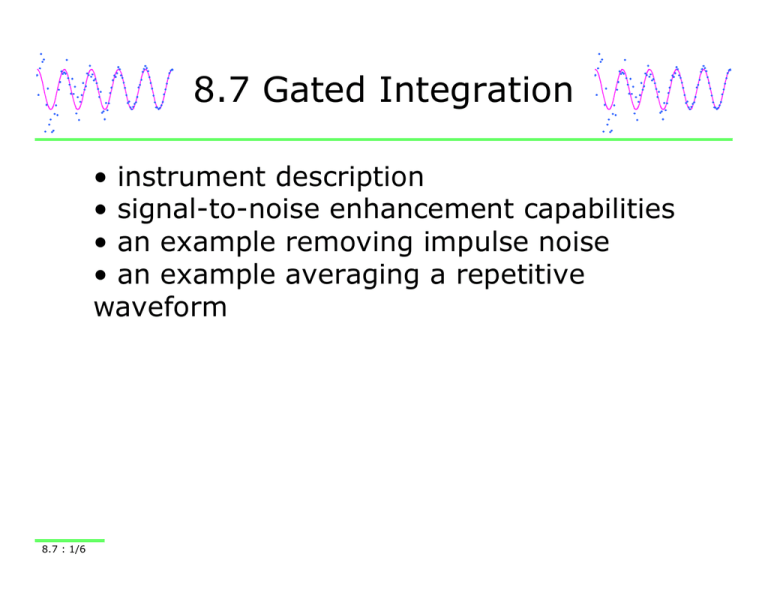8.7 Gated Integration
advertisement

8.7 Gated Integration • instrument description • signal-to-noise enhancement capabilities • an example removing impulse noise • an example averaging a repetitive waveform 8.7 : 1/6 Instrument Gated integrators are used to remove impulse noise, or to average fast, repetitive signals. To a great extent they have been replaced by computer-controlled digital oscilloscopes. output mixer input R C trigger delay generator pulse generator pulse • the input is impedance buffered width by a voltage follower • the trigger starts a delay generator, which can be fixed in time or incremented an amount, Δτ, for every trigger event • the delay generator triggers a rectangular pulse generator, which can be adjusted from nanoseconds to milliseconds • the mixer blocks the signal (multiplies by zero) until the rectangular pulse arrives (which multiplies the signal by one) • the capacitor becomes charged to the average voltage of the signal during the gating pulse • after the mixer is turned off, the capacitor maintains the signal voltage until the next mixer-on event • the output of the follower is fed into a low pass filter 8.7 : 2/6 Signal-to-Noise Enhancement The signal must be repetitive. There must be an electrical signal synchronized with the signal which can be used to define zero delay. If the width of the gate pulse is much larger than RC (see the circuit), it determines the temporal resolution. If the gated integrator is used to remove impulse noise, the amount of signal-to-noise enhancement is best determined in the time domain. If the gated integrator is used to record a fast signal in the absence of impulse noise, a frequency domain analysis will give a reasonable estimate of the signal-to-noise enhancement. Let frep be the repetition rate of the experiment, and let f3dB be the 3dB frequency of the low pass filter used on the output of the integrator. The signal-to-noise enhancement is given by: SNE = f rep 2 f3dB With a 100 Hz experiment and RC = 1, the enhancement is 100/2×0.16 = 314. 8.7 : 3/6 Removing Impulse Noise 1.6 interference amplitude (V) Suppose the signal is ion current after a laser ablation event, and the area under the curve is proportional to some elemental concentration on the surface of a sample. The laser ablation is repeated and the signal averaged until the desired signal-tonoise ratio is obtained. gate pulse 1.2 trigger 0.8 delay 0.4 signal 0 0 20 40 60 80 time (ns) The width and the delay of the gate pulse are determined by trial and error. Once an optimum signal-to-noise ratio is found, the width and delay are fixed. 8.7 : 4/6 100 Averaging a Repetitive Waveform 1.6 amplitude (V) The goal of the experiment is to recover the exponential decay constant. The impulse interference might be scattered Rayleigh light. 1.4 1.2 gate pulse interference 1 trigger scanned delay 0.8 initial delay 0.6 signal 0.4 0.2 0 0 20 40 60 80 time (ns) The width of the gate pulse is reduced as much as possible to minimize distortion of the recorded exponential decay. The initial delay is used to avoid recording the interference. The delay is incremented a small amount every time the experiment is repeated. The averaged output as a function of delay will be proportional to the original signal as a function of time. 8.7 : 5/6 100 Gated Integration Transfer Function The temporal transfer function involves multiplication by a rectangle. Since this is a single rectangle with a position that is not necessarily symmetric about t = 0, the shift theorem needs to be invoked. Thus the spectral transfer function is complex valued and involves convolution on both the real and imaginary axes. When scanning the delay, the e±2πft' term in the shift theorem is constantly changing, making the analysis even more complicated. For experiments using a fixed delay with averaging, the affect of averaging has to be included in both the temporal and spectral transfer function. Because of the difficulty in developing a simple spectral transfer function they are seldom used with gated integration. 8.7 : 6/6



![[ ] [ ] ( )](http://s2.studylib.net/store/data/011910597_1-a3eef2b7e8a588bc8a51e394ff0b5e0e-300x300.png)